Comment faire en sorte que vos clients tombent amoureux de vous ?
7 secrets simples pour un meilleur produit et des ventes plus faciles
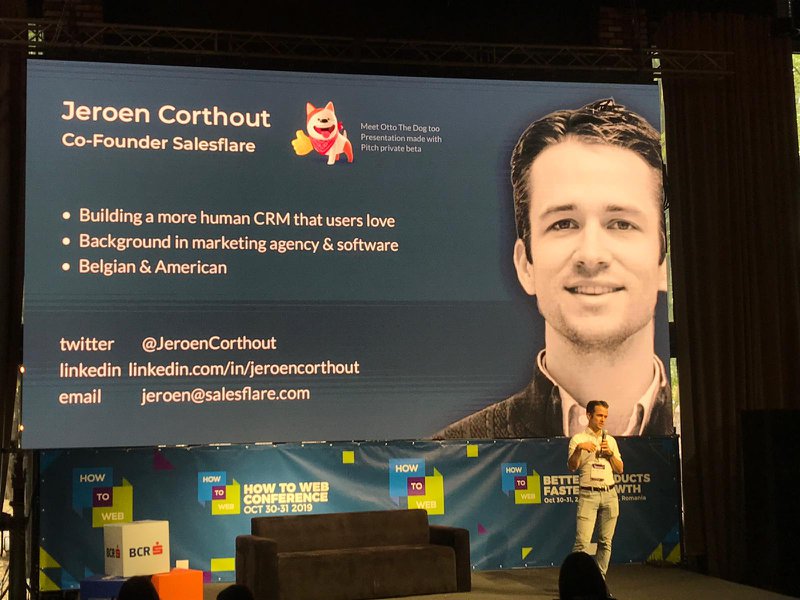
Il y a exactement une semaine, je prenais la parole à HowToWeb 2019 à Bucarest, en Roumanie. La dixième édition d'une conférence qui fait date dans la région des PECO.
J'ai été honoré de faire partie d'un groupe d'orateurs aussi prestigieux, comprenant des leaders d'opinion comme Sean Ellis (growth hacking), April Dunford (positionnement), Bob Moesta (emplois à pourvoir) et Michael Perry (esprit d'entreprise).
The theme of the conference is “Better Products, Faster Growth” and that’s what I was asked to talk about as well.
As the local tech ecosystem is gearing up, there’s still a gap between ambitions and execution, especially when it comes to building products that people want and then managing to sell them.
That’s why I shared 7 principles that make a big difference when starting off a product business, in the hope to bring some inspiration to the founders or aspiring founders in the room.
Coincidentally – or not – many of my fellow speakers touched on these same topics during their talks. I’ve linked to those talks wherever I can, so you can go into that too if you like.
Tout est prêt ? Le micro et le clicker fonctionnent ?
3 – 2 – 1. Here we go 😁
Comment faire en sorte que vos clients tombent amoureux de vous ?
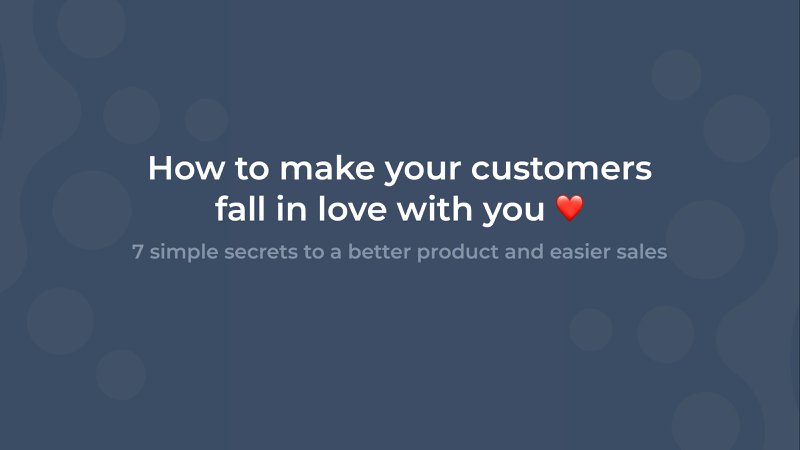
Hello everyone! I’m Jeroen of Salesflare. My goal with this talk today is to help you develop a product and a sales process your customers can fall in love with.
I’ll be sharing some simple but fundamental secrets on how to do that. I hope that’s what you came to this talk for. If it is, sit tight!
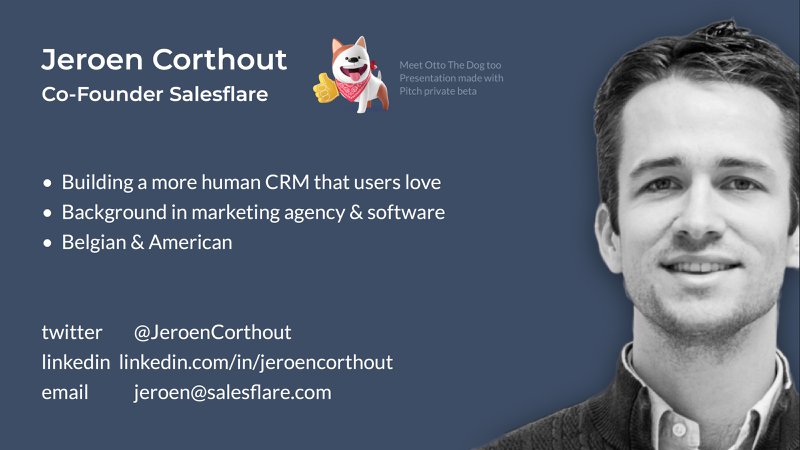
About me: like I said, I’m Jeroen, co-founder of Salesflare, which is a CRM software company.
Parmi plus de 600 concurrents, Salesflare se distingue par un produit CRM facile à utiliser et automatisé que les PME ont tendance à aimer.
J'ai travaillé dans une agence de marketing et dans le développement de logiciels, comme la plupart d'entre vous, je suppose.
And I come to you and HowToWeb from the country of beer, chocolate and waffles, called Belgium. I’m also a US citizen by birth, as I was born in a little town in upstate New York.
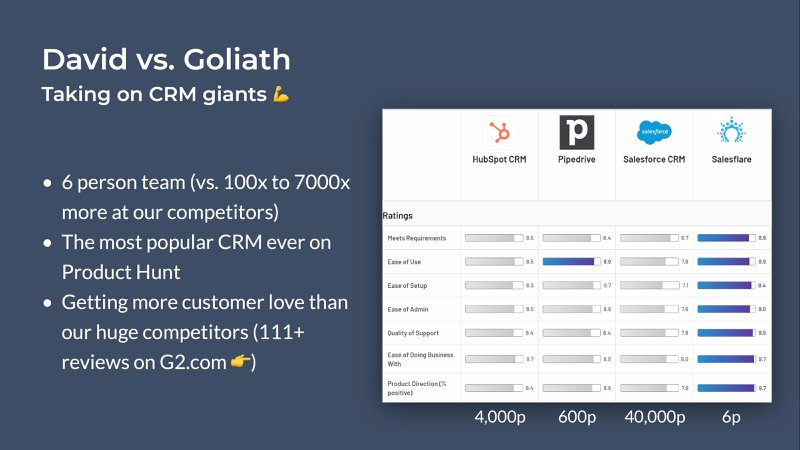
Ainsi, si vous comparez Salesflare à nos principaux concurrents, vous serez probablement frappé par le fait que nous sommes des centaines, voire des milliers de fois plus petits qu'eux en termes d'effectifs.
Néanmoins, nous servons des milliers de clients avec un produit comparable et nous recevons beaucoup plus d'affection de la part de nos clients que de nos concurrents, comme en témoignent nos scores sur G2 ici à droite.
Cet exposé a pour but de vous aider à comprendre comment vous pouvez recréer le même effet. Et comment vous pouvez créer un meilleur produit et avoir des ventes plus faciles en tant que petite entreprise en devenir.

Chez Salesflare, nous avons construit une machine à créer de la valeur pour les clients qui se concentre sur la création de valeur pour les clients.
Cela signifie que nous faisons deux choses : 1. nous parlons à nos clients, et 2. nous construisons pour eux un produit et un contenu de valeur qui les aident à être meilleurs dans leur travail.
Et nous faisons tout cela à un rythme très rapide et très constant.
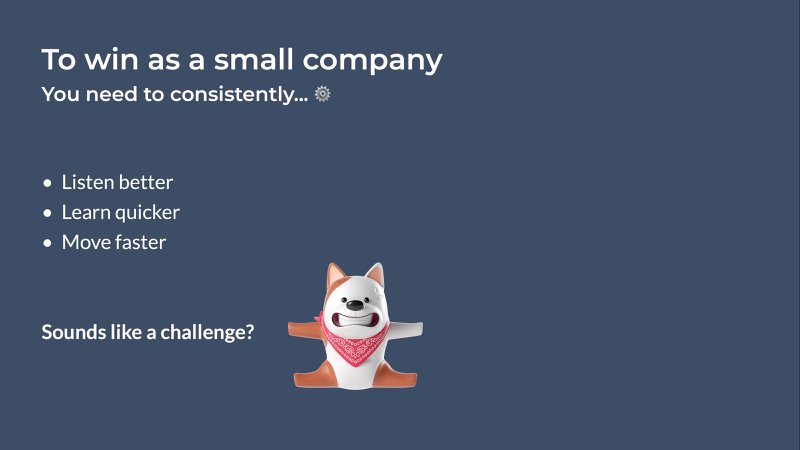
Pour gagner en tant que petite entreprise, la compréhension du client, la rapidité et la cohérence sont essentielles.
It’s your weapons against the giants in your space. It’s your well aimed slingshots that can defeat them.
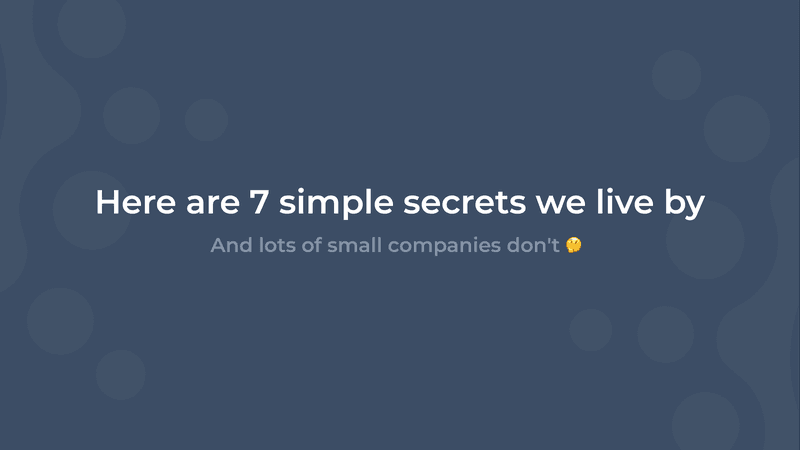
Comment pouvez-vous atteindre ces trois objectifs ? Laissez-moi vous expliquer comment nous procédons.
And I’m not going to tell you our way is the only way and you need to copy it literally, but at least I hope I can inspire you with our approach.
So let’s start with the very simple but fundamental basics, with rule nr 1 …
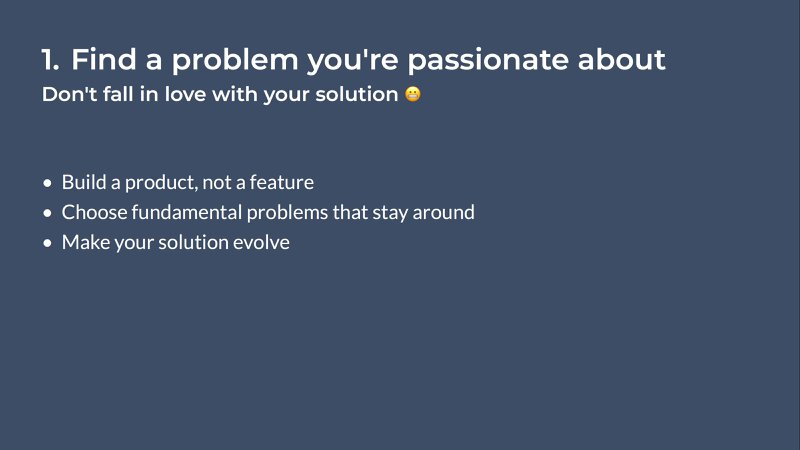
… which is to “find a fundamental problem you’re passionate about”.
Chez Salesflare, nous nous concentrons sur le problème des mauvaises données CRM et nous aidons les entreprises à satisfaire leurs clients grâce à de meilleures données.
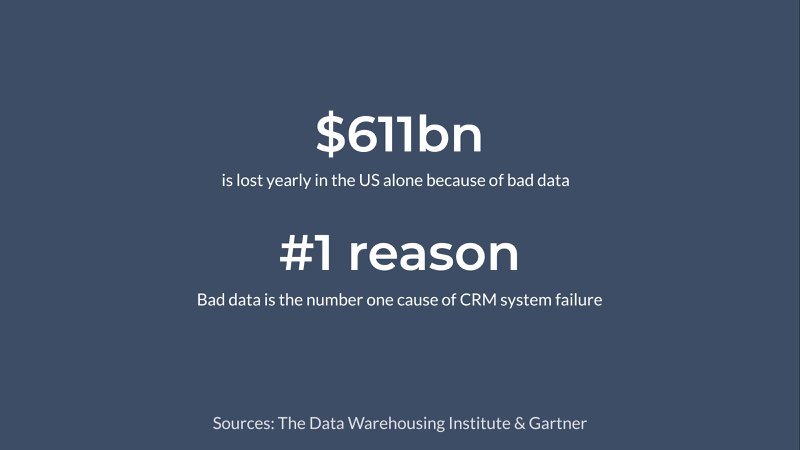
The initial solution we came up with and that we offer is automated collection of data from emails, calendar, phone, … but that’s not really where we stop. We are thinking about integrating new communication channels, we are thinking about adding new ways of combining data, about adding new types of sales intelligence, and even maybe about completely different things that solve the same issue or reinforce our solution.
It is after all really dangerous if you’re just building a feature, like -say- software that automatically imports email signatures and adds them to your contact database.
Ce type de fonctionnalité peut devenir obsolète très facilement si, par exemple, Google, Microsoft ou Apple décident de l'ajouter à leurs solutions de courrier électronique. Dans ce cas, vous serez au bord de la mort.
Au contraire, alors que les solutions et les fonctionnalités sont facilement copiées et remplacées, les problèmes, eux, restent et constituent une base beaucoup plus solide pour votre entreprise.
This is something that my fellow speaker Michael Perry from Shopify will discuss in his talk later on about his 13 year journey in startups, as one of the mistakes he’s made along the way. (Check it out in the Facebook Live video here at the -0:45 mark; this talk made me quite emotional and the message Michael’s bringing is a very important one, so don’t miss out.)

Now, after you’ve found some fundamental problem, you should verify that it’s a problem that a group of people face, that you can actually identify with.
Dans notre cas, nos utilisateurs sont principalement des agences (j'ai travaillé dans une agence de marketing auparavant) et, d'autre part, des sociétés de logiciels (évidemment, je dirige une société de logiciels en ce moment).
Même s'il s'agit d'un espace très encombré, nous connaissons très bien le fonctionnement des agences et des sociétés de logiciels, nous connaissons leurs problèmes et nous connaissons aussi beaucoup d'entre eux. Ce qui nous aide énormément.
Sometimes people tell me that we should focus on another, much easier market. And often it comes up that there’s huge potential in the market for, for instance, a better CRM for real estate. This would indeed be way easier, as the real estate market is rather underdeveloped in terms of software solutions, and especially in terms of CRMs.
The thing however is: I wouldn’t be hanging out with you here and I wouldn’t be having conversations that genuinely interest me. Instead, I would be hanging out at a real estate conference and I would be eating my heart out.
Real estate people are not really “my people”. I don’t enjoy talking about selling real estate that much. And how badly actually would our company do if I didn’t enjoy talking to our customers.
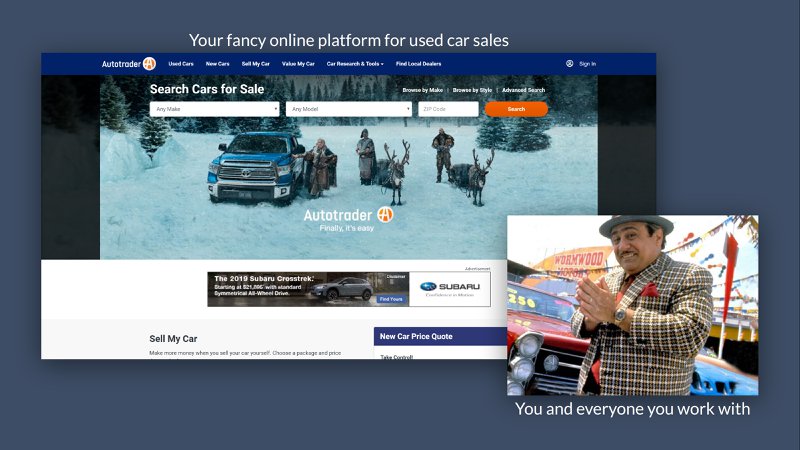
Hypothetically, it could also be that you’ve seen a once in a lifetime opportunity in building an online platform for second hand car sales.
Maybe you’d think: “I’m building it for people like you and me, I will like this”; but in the end, you will be a used car salesman, meeting and competing with other used car salesmen, and you might start feeling miserable after a little while if this doesn’t fit you.
En fait, si l'on suit ce raisonnement et cette règle encore plus loin, l'idéal est de commencer par créer un public qui vous aime et vous fait confiance, et vice-versa. Ce n'est qu'ensuite que vous découvrirez leurs problèmes et que vous créerez une solution.
Now, we don’t all have that luxury, but if you can at least create something for people you like and understand, it will move you a big step forward yet again.
If you’ve seen April Dunford’s talk this morning, you also understand that selecting your audience will define your positioning and product to a large extent, so don’t mess it up. (Visualisez son intervention dans la vidéo Facebook Live ici à la marque -6:26:00. Cela pourrait faire la différence entre le succès et l'échec de votre entreprise.)
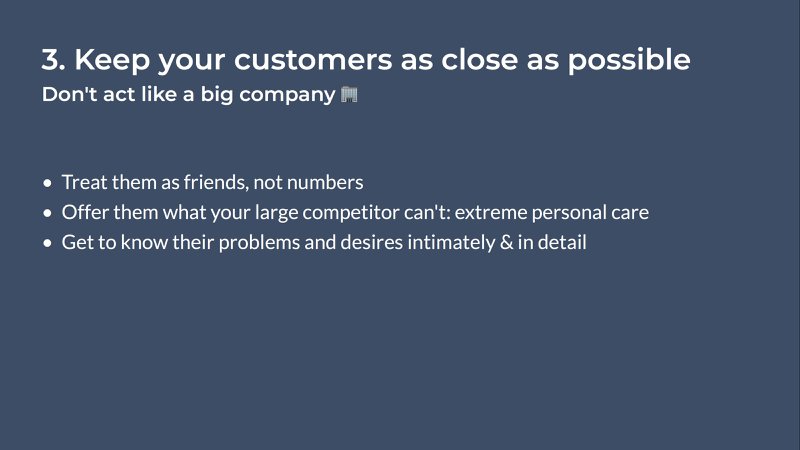
Third, it’s very important as a small company to play out your advantage as a small company. And not to start acting like a big company.
Will the CEOs of our competitors get on onboarding calls with their customers, connect with them on LinkedIn or Facebook, help them to solve their issues personally, … ? I think, with the exception of some key customers, no, they definitely won’t.
We have thousands of customers using our software and as we work very closely with them, I still know personally who many of them are, what they care about, how they think, …
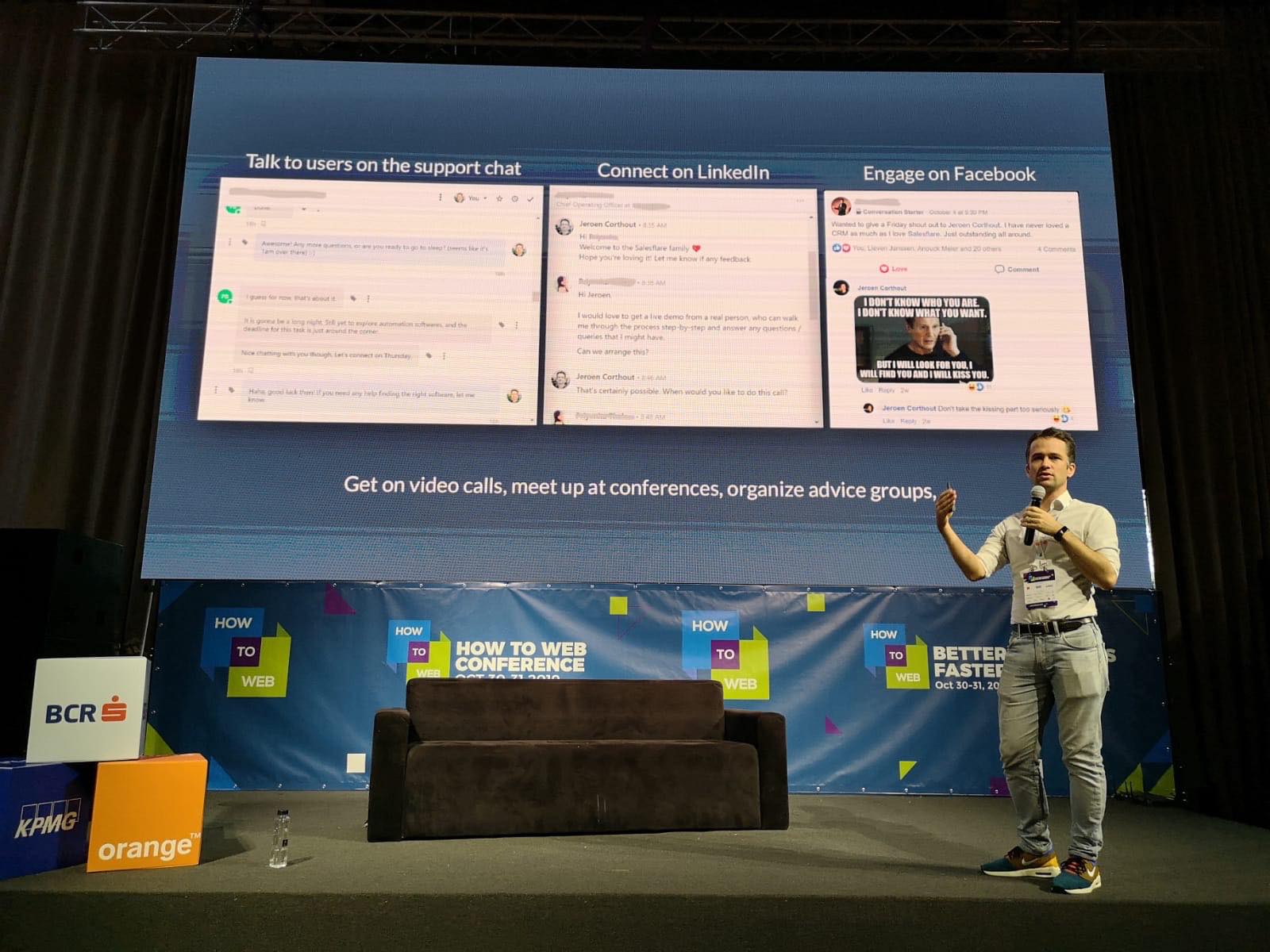
All in all, I think being in touch with customers takes about 10-20% of my time, but it’s my best spent time. And it’s worth it. It gives me energy, it helps us to understand our customers, to build stronger relationships, … It’s really the best spent time of all.
Still, I see many companies trying to act like a big company, because they believe it’s the only way to get credibility and to be trusted; I tell you: there’s a much better way to gain their trust and it’s investing in a strong relationship; this will pay off big time.
Back to the G2 chart I showed earlier, you can see there that “ease of doing business with” Salesflare is our highest score by far. That’s not a coincidence. It’s a direct result of our focus on close relationships with our customers.
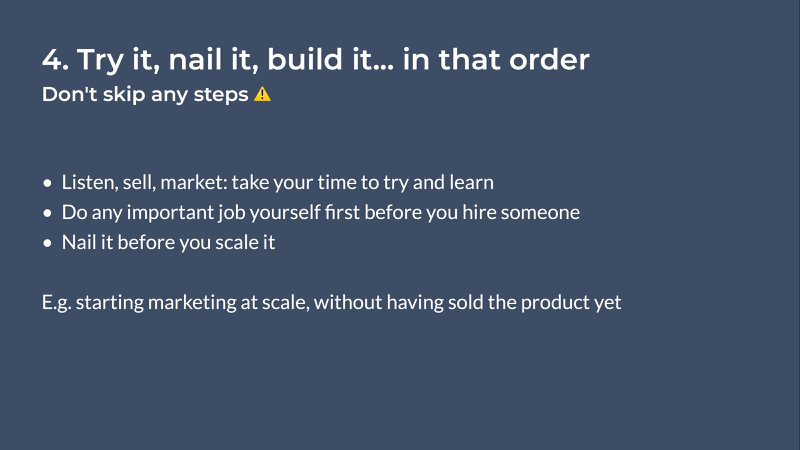
The fourth important rule is not to skip any steps along the way. You’ll often be tempted to do it, but just don’t.
Étant donné que beaucoup de gens apprécient notre approche marketing chez Salesflare, les fondateurs de startups en phase de démarrage me demandent souvent comment ils devraient s'y prendre pour faire leur marketing.
And when they do and we meet up, I’ll first start with listening to what they sell, to whom they sell it, and then I will ask: “So how many people have you sold this to already?”
Almost invariably, the answer will be between 0 and 5 people, which means they haven’t even figured out a way to get repeated sales – so why on earth would they even care to start marketing?
Et ce n'est que le symptôme d'un problème plus vaste, car les petites entreprises en général veulent devenir grandes trop rapidement et sautent des étapes essentielles en cours de route, sur tous les fronts.

When my co-founder and I started Salesflare, the first thing we did is reading the book “Getting Real” by 37signals (which I can very much recommend – and it’s free) and we rigorously applied the principles from that book; we first made a presentation, and we made a mockup, and we started doing lots of interviews to understand what people needed and why they’d see us fail at building Salesflare.
Ever since then, everything we have done at Salesflare we have first tried manually and at its most basic level, and then we have repeated this until we nailed it, and only then we’ve scaled it.
As an example, for 1 to 2 years I’ve personally gone on Skype calls with screen sharing to onboard customers on our software, connect their emails, do their imports, see what they didn’t understand or lacked. And I could experience everything firsthand. It gave me very direct pain.
If, instead, we would have made a fully self-service onboarding from the start, I’m certain we would have missed so many learnings and we would have spent so much more time perfecting Salesflare, if by then we wouldn’t have run out of money already.
Of course, we have made many mistakes too, like hiring people before we nailed the job ourselves, which made iterating to find the right solution ten times slower. That’s why I recommend to you: do the job first yourself, and only then get someone else to do it better than you. But figure out the basic strategy before you hire that person, otherwise you might easily get stuck in the very same place.
Actually, a great example of the “nail it before you scale it” way of thinking is how the guys at Sympl, the company with whom we share an office, built out their full recruitment solution first using 1. Zapier, 2. a simple database solution and 3. Slack.
They didn’t start coding at all. Instead, they first made sure they knew exactly what they wanted to code, and they saved months -if not years- doing so.
If you haven’t seen yesterday’s talk by fellow speaker Paolo Ertreo from Dropbox, check it out online. It’s full of great insights in how to do iteration right, and it’s applicable to both your product and your sales. (Check out his talk in the Facebook Live video here at the -0:36:30 mark. You’ll always remember the pebbles and boulders analogy.)
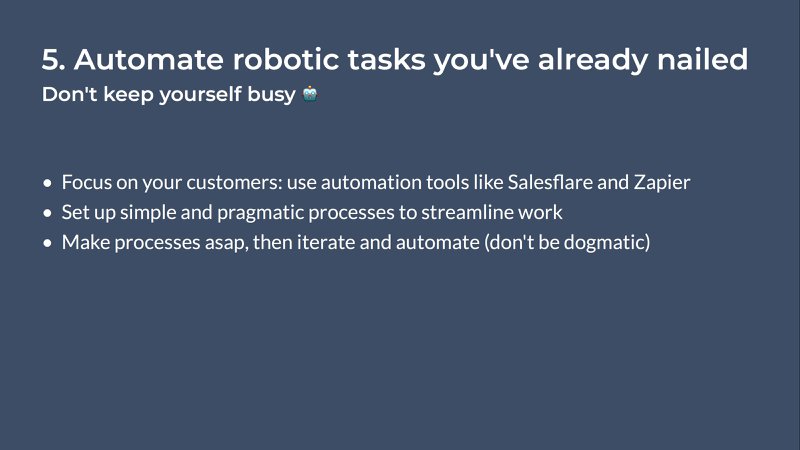
Fifth, once you’ve nailed some of the tasks, start automating them.
When I’m saying “nail it before you scale it”, that obviously doesn’t mean you should keep yourself busy with groundwork for the rest of time.
Again, if you’re in a software company or you’re in an agency, you have two jobs: 1 is talking to customers and 2 is building valuable stuff for them. Everything else is secondary and should be as automated as possible, as soon as you have nailed it.
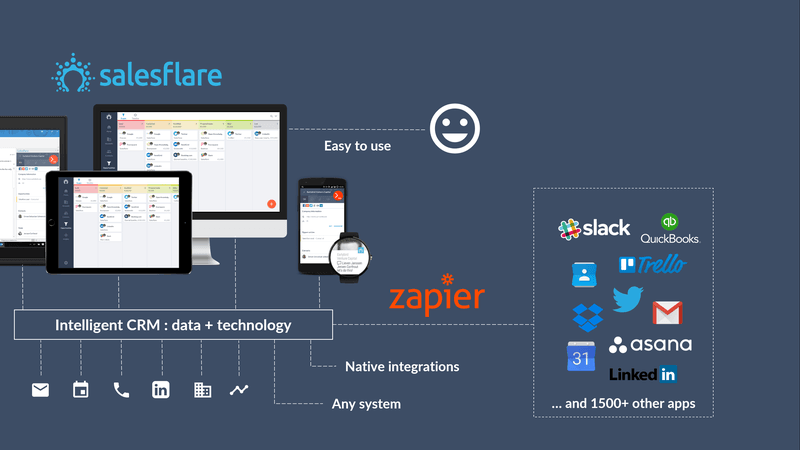
Salesflare itself, the product, was created to scratch an automation itch we had ourselves, which was having to document our every interaction with customers, plus their details. This is of course essential to be able to talk to customers, but it’s not the talking to customers itself. It only has a supporting role, it’s robotic work, and we believed it should be automated. In fact, we’ve already proven that computers do a much better job at this than we do.
Next to using Salesflare, and at Salesflare, we have tens of other software products running for us that automate the little things in our workflow and we all connect them together with Zapier, so it kinda all runs like a clockwork and we don’t need to spend our time moving data from here to there. It just runs by itself for us.
Il est important de noter qu'une grande partie de l'automatisation de votre travail consiste souvent à créer d'abord un processus simple pour mieux l'organiser. Cela permet d'éviter beaucoup de communications inutiles si vous vous mettez d'accord sur la manière de travailler ensemble, et cela permet souvent une automatisation plus facile par la suite.
Si vous faites quelque chose pour la dixième ou la vingtième fois et que vous savez comment cela fonctionne le mieux, commencez à le documenter, puis automatisez-le ou déléguez-le.
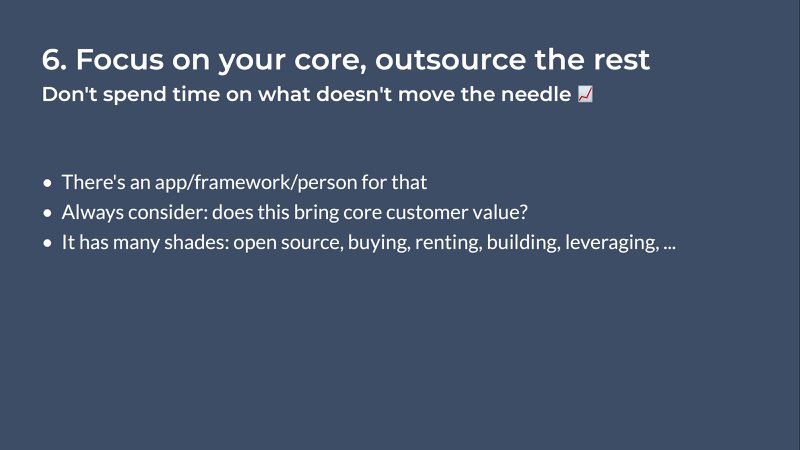
So imagine again being 6 people and competing with companies that are hundreds to thousands of times bigger… and you want to do better. In this case, you need to be very focused at doing the exact right things better.
Today, and thanks to the internet and everyone contributing to it, it’s easier than ever before for small companies to build your software and reach your audience, without needing to take care of all the secondary things.
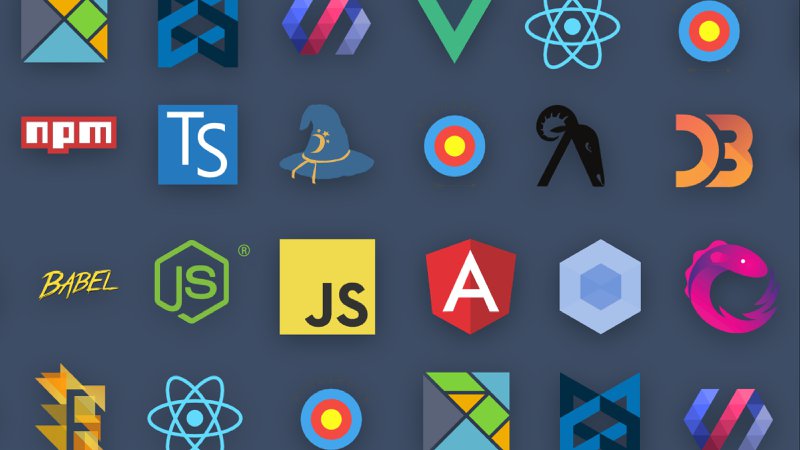
Even if you obsess about UX like we do, you don’t need to build your own UI components. You can just use a framework.
Even if your main premise is to pull data from everywhere, you don’t need to build your own connectors; at least certainly not at first.
Nous avons par exemple commencé par utiliser une plateforme externe pour synchroniser les courriels, que nous avons remplacée deux ans plus tard par notre propre intégration, car nous avons compris qu'il était logique d'intégrer cette technologie dans notre cœur de métier.
This makes that our CRM now has the fastest, most stable and most powerful email integration around with Google Workspace and Office 365, which is now a competitive advantage vs the rest. So it was an important thing to do, but it wasn’t important to do this from the very beginning.
Pour tout ce qui ne fait pas partie de vos valeurs fondamentales actuelles, cherchez des moyens créatifs de construire plus rapidement ce dont vous avez besoin. Et il existe de très nombreuses façons de le faire.
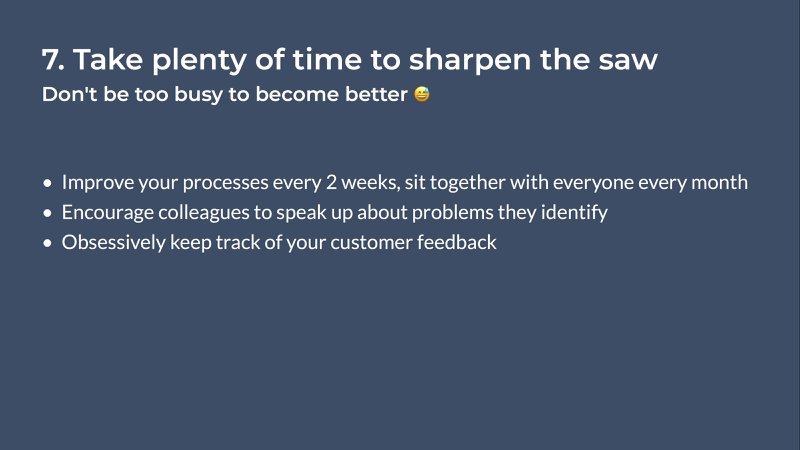
Enfin, prenez le temps de vous améliorer.
For those who haven’t read Stephen Covey’s “The 7 Habits of Highly Effective People”, coincidentally their 7th habit is the same as the 7th habit of highly effective small companies: never be too busy sawing, to stop and sharpen the saw.
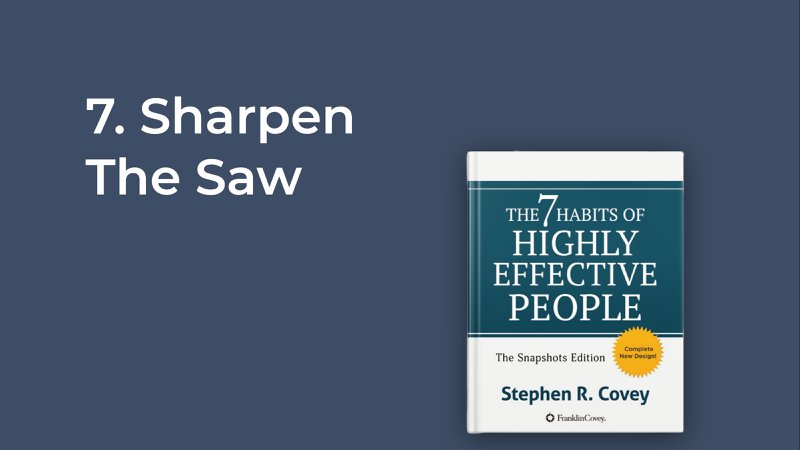
Your main goal should remain to beat the status quo and to become a better company than yesterday. Even if it’s just with 1% increments every day, it will all add up in the end.
What we have done for five years straight now is sit together with the whole team every two weeks for two or three hours and discuss what’s going well and especially what’s not going well.
Nous écrivons tout cela sur un tableau blanc et nous réservons suffisamment d'espace pour trouver des solutions aux points négatifs et pour tirer des enseignements des points positifs. Ensuite, nous travaillons sur les solutions et nous tirons parti des enseignements.
Nous encourageons chacun d'entre nous à identifier les problèmes, à ne pas les ignorer, afin de sortir de notre statu quo ou de notre zone de confort et de les résoudre.
Il en va de même pour la manière dont nous travaillons avec les clients. Nous les encourageons activement à nous faire part de leurs commentaires et nous les récompensons par des messages personnels lorsque nous donnons suite à leurs remarques.
It’s only because we care deeply about becoming better, that we can actually outperform our competitors and get these amazing customer review scores I showed you at the beginning.
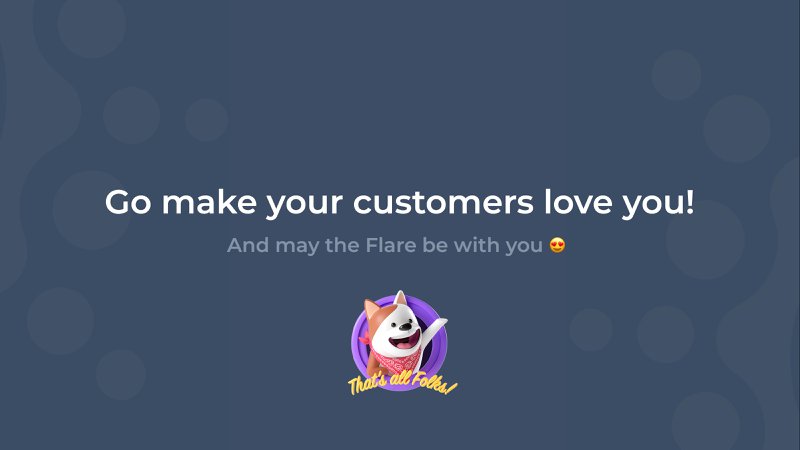
And that’s it. Those are our 7 simple secrets. I hope you’ll be able to take at least one of them home and use it to improve your business.
Maintenant, faites en sorte que vos clients tombent amoureux de vous !
Je vous remercie ! Et que la flamme soit avec vous !
P.S. Cette présentation a été réalisée en utilisant la version bêta privée de Pitch. D'où les autocollants Otto The Dog. Vous pouvez également apprécier la présentation sur ce lien public.
“Salesflare is smart and turns CRM from something “I have to do” into a tool that helps me focus on why I started my business.”
Michael Clingan, The Claymore Group

Nous espérons que cet article vous a plu. Si c'est le cas, passez le mot !
👉 Vous pouvez suivre @salesflare sur Twitter, Facebook et LinkedIn.
- 8 avantages du CRM + 6 défis à surmonter en premier lieu - avril 18, 2024
- 30+ meilleurs outils de génération de leads (par type) - avril 16, 2024
- 7 Best CRMs for Google Workspace + Integration Features - avril 11, 2024
